Europe, British Isles, North-Central England, Lincolnshire, Stamford [Map]
Stamford is in Lincolnshire.
1190 Massacre of the Jews at Stamford
1470 Welles' Rebellion and Battle of Losecoat Field aka Empingham
Anglo-Saxon Chronicle. 656. This year was Peada slain; and Wulfhere (age 16), son of Penda, succeeded to the kingdom of the Mercians. In his time waxed the abbey of Medhamsted [Map] very rich, which his brother had begun. The king (age 16) loved it much, for the love of his brother Peada, and for the love of his wed-brother Oswy (age 44), and for the love of Saxulf the abbot. He said, therefore, that he would dignify and honour it by the counsel of his brothers, Ethelred and Merwal; and by the counsel of his sisters, Kyneburga and Kyneswitha; and by the counsel of the archbishop, who was called Deus-dedit; and by the counsel of all his peers, learned and lewd, that in his kingdom were. And he so did. Then sent the king after the abbot, that he should immediately come to him. And he so did. Then said the king to the abbot: "Beloved Saxulf, I have sent after thee for the good of my soul; and I will plainly tell thee for why. My brother Peada and my beloved friend Oswy (age 44) began a minster, for the love of Christ and St. Peter: but my brother, as Christ willed, is departed from this life; I will therefore intreat thee, beloved friend, that they earnestly proceed on their work; and I will find thee thereto gold and silver, land and possessions, and all that thereto behoveth." Then went the abbot home, and began to work. So he sped, as Christ permitted him; so that in a few years was that minster ready. Then, when the king (age 16) heard say that, he was very glad; and bade men send through all the nation, after all his thanes; after the archbishop, and after bishops: and after his earls; and after all those that loved God; that they should come to him. And he fixed the day when men should hallow the minster. And when they were hallowing the minster, there was the king, Wulfere (age 16), and his brother Ethelred, and his sisters, Kyneburga and Kyneswitha. And the minster was hallowed by Archbishop Deusdedit of Canterbury; and the Bishop of Rochester, Ithamar; and the Bishop of London, who was called Wina; and the Bishop of the Mercians, whose name was Jeruman; and Bishop Tuda. And there was Wilfrid, priest, that after was bishop; and there were all his thanes that were in his kingdom. When the minster [Map] was hallowed, in the name of St. Peter, and St. Paul, and St. Andrew, then stood up the king before all his thanes, and said with a loud voice: "Thanks be to the high almighty God for this worship that here is done; and I will this day glorify Christ and St. Peter, and I will that you all confirm my words.-I Wulfere give to-day to St. Peter, and the Abbot Saxulf, and the monks of the minster, these lands, and these waters, and meres, and fens, and weirs, and all the lands that thereabout lye, that are of my kingdom, freely, so that no man have there any ingress, but the abbot and the monks. This is the gift. From Medhamsted to Northborough; and so to the place that is called Foleys; and so all the fen, right to Ashdike; and from Ashdike to the place called Fethermouth; and so in a right line ten miles long to Ugdike; and so to Ragwell; and from Ragwell five miles to the main river that goeth to Elm and to Wisbeach; and so about three miles to Trokenholt; and from Trokenholt right through all the fen to Derworth; that is twenty miles long; and so to Great Cross; and from Great Cross through a clear water called Bradney; and thence six miles to Paxlade; and so forth through all the meres and fens that lye toward Huntingdon-port; and the meres and lakes Shelfermere and Wittlesey mere, and all the others that thereabout lye; with land and with houses that are on the east side of Shelfermere; thence all the fens to Medhamsted; from Medhamsted all to Welmsford; from Welmsford to Clive; thence to Easton; from Easton to Stamford [Map]; from Stamford as the water runneth to the aforesaid Northborough." - These are the lands and the fens that the king gave unto St. Peter's minster.-Then quoth the king: "It is little-this gift- but I will that they hold it so royally and so freely, that there be taken there from neither gild nor gable, but for the monks alone. Thus I will free this minster; that it be not subject except to Rome alone; and hither I will that we seek St. Peter, all that to Rome cannot go." During these words the abbot desired that he would gant him his request. And the king granted it. "I have here (said he) some good monks that would lead their life in retirement, if they wist where. Now here is an island, that is called Ankerig; and I will request, that we may there build a minster to the honour of St. Mary; that they may dwell there who will lead their lives in peace and tranquillity." Then answered the king, and quoth thus: "Beloved Saxulf, not that only which thou desirest, but all things that I know thou desirest in our Lord's behalf, so I approve, and grant. And I bid thee, brother Ethelred, and my sisters, Kyneburga and Kyneswitha, for the release of your souls, that you be witnesses, and that you subscribe it with your fingers. And I pray all that come after me, be they my sons, be they my brethren, or kings that come after me, that our gift may stand; as they would be partakers of the life everlasting, and as they would avoid everlasting punishment. Whoso lesseneth our gift, or the gift of other good men, may the heavenly porter lessen him in the kingdom of heaven; and whoso advanceth it, may the heavenly porter advance him in the kingdom of heaven." These are the witnesses that were there, and that subscribed it with their fingers on the cross of Christ, and confirmed it with their tongues. That was, first the king, Wulfere, who confirmed it first with his word, and afterwards wrote with his finger on the cross of Christ, saying thus: "I Wulfere, king, in the presence of kings, and of earls, and of captains, and of thanes, the witnesses of my gift, before the Archbishop Deus-dedit, I confirm it with the cross of Christ." (+)-"And I Oswy, king of the Northumbrians, the friend of this minster, and o[oe] the Abbot Saxulf, commend it with the cross of Christ." (+)-"And I Sighere, king, ratify it with the cross of Christ." (+)-"And I Sibbi, king, subscribe it with the cross of Christ." (+)-"And I Ethelred, the king's brother, granted the same with the cross of Christ." (+)-"And we, the king's sisters, Kyneburga and Kyneswitha, approve it."-"And I Archbishop of Canterbury, Deus-dedit, ratify it."-Then confirmed it all the others that were there with the cross of Christ (+): namely, Ithamar, Bishop of Rochester; Wina, Bishop of London; Jeruman, Bishop of the Mercians; and Tuda, bishop; and Wilfrid, priest, who was afterwards bishop; and Eoppa, priest, whom the king, Wulfere, sent to preach christianity in the Isle of Wight; and Saxulf, abbot; and Immine, alderman, and Edbert, alderman, and Herefrith, alderman, and Wilbert, alderman, and Abo, alderman; Ethelbald, Brord, Wilbert, Elmund, Frethegis. These, and many others that were there, the king's most loyal subjects, confirmed it all. This charter was written after our Lord's Nativity 664-the seventh year of King Wulfere-the ninth year of Archbishop Deus-dedir. Then they laid God's curse, and the curse of all saints, and all christian folks, on whosoever undid anything that there was done. "So be it," saith all. "Amen."-When this thing was done, then sent the king to Rome to the Pope Vitalianus that then was, and desired, that he would ratify with his writ and with his blessing, all this aforesaid thing. And the pope then sent his writ, thus saying: "I Vitalianus, pope, grant thee, King Wulfere, and Deus-dedit, archbishop, and Abbot Saxulf, all the things that you desire. And I forbid, that any king, or any man, have any ingress, but the abbot alone; nor shall he be Subject to any man, except the Pope of Rome and the Archbishop of Canterbury. If any one breaketh anything of this, St. Peter with his sword destroy him. Whosoever holdeth it, St. Peter with heaven's key undo him the kingdom of heaven."-Thus was the minster of Medhamsted begun, that was afterwards called Peter-borough. Afterwards came another archbishop to Canterbury, who was called Theodorus (age 54); a very good man and wise; and held his synod with his bishops and with his clerk. There was Wilfrid, bishop of the Mercians, deprived of his bishopric; and Saxulf, abbot, was there chosen bishop; and Cuthbald, monk of the same minster, was chosen abbot. This synod was holden after our Lord's Nativity six hundred and seventy-three winters.
Anglo-Saxon Chronicle. 917. This year, betwixt gang-days and midsummer, went King Edward (age 43) with his army to Stamford [Map], and ordered the town to be fortified on the south side of the river. And all the people that belonged to the northern town submitted to him, and sought him for their lord. It was whilst he was tarrying there, that Ethelfleda (age 47) his sister died at Tamworth [Map], twelve nights before midsummer. Then rode he to the borough of Tamworth; and all the population in Mercia turned to him, who before were subject to Ethelfleda (age 47). And the kings in North-Wales, Howel, and Cledauc, and Jothwel, and all the people of North-Wales, sought him for their lord. Then went he thence to Nottingham [Map], and secured that borough, and ordered it to be repaired, and manned both with English and with Danes. And all the population turned to him, that was settled in Mercia, both Danish and English.
Anglo-Saxon Chronicle. 1016. This year came King Knute (age 21) with a marine force of one hundred and sixty ships, and Earldorman Eadric "Streona aka Acquisitive" Mercia with him, over the Thames into Mercia at Cricklade, Wiltshire [Map]; whence they proceeded to Warwickshire, during the middle of the winter, and plundered therein, and burned, and slew all they met. Then began Edmund the etheling (age 26) to gather an army, which, when it was collected, could avail him nothing, unless the king (age 50) were there and they had the assistance of the citizens of London. The expedition therefore was frustrated, and each man betook himself home. After this, an army was again ordered, under full penalties, that every person, however distant, should go forth; and they sent to the king (age 50) in London, and besought him to come to meet the army with the aid that he could collect. When they were all assembled, it succeeded nothing better than it often did before; and, when it was told the king, that those persons would betray him who ought to assist him, then forsook he the army, and returned again to London. Then rode Edmund the etheling (age 26) to Earl Utred in Northumbria; and every man supposed that they would collect an army King Knute (age 21); but they went into Stafforddhire, and to Shrewsbury, Shropshire [Map], and to Chester [Map]; and they plundered on their parts, and Knute (age 21) on his. He went out through Buckinghamshire to Bedfordshire; thence to Huntingdonshire, and so into Northamptonshire along the fens to Stamford [Map]. Thence into Lincolnshire. Thence to Nottinghamshire; and so into Northumbria toward York [Map]. When Utred understood this, he ceased from plundering, and hastened northward, and submitted for need, and all the Northumbrians with him; but, though he gave hostages, he was nevertheless slain by the advice of Earldorman Eadric "Streona aka Acquisitive" Mercia, and Thurkytel, the son of Nafan, with him. After this, King Knute (age 21) appointed Eric earl over Northumbria, as Utred was; and then went southward another way, all by west, till the whole army came, before Easter, to the ships. Meantime Edmund Etheling (age 26) went to London to his father (age 50): and after Easter went King Knute (age 21) with all his ships toward London; but it happened that King Ethelred (age 50) died ere the ships came. He ended his days on St. George's day; having held his kingdom in much tribulation and difficulty as long as his life continued.
Anglo-Saxon Chronicle. 1127. This same year he155 gave the abbacy of Peterborough to an abbot named Henry of Poitou, who retained in hand his abbacy of St. John of Angeli; but all the archbishops and bishops said that it was against right, and that he could not have two abbacies on hand. But the same Henry gave the king (age 59) to understand, that he had relinquished his abbacy on account of the great hostility that was in the land; and that he did through the counsel and leave of the Pope of Rome, and through that of the Abbot of Clugny, and because he was legate of the Rome-scot. But, nevertheless, it was not so; for he would retain both in hand; and did so as long as God's will was. He was in his clerical state Bishop of Soissons; afterwards monk of Clugny; and then prior in the same monastery. Afterwards he became prior of Sevigny; and then, because he was a relation of the King of England (age 59), and of the Earl of Poitou, the earl gave him the abbacy of St. John's minster of Angeli. Afterwards, through his great craft, he obtained the archbishopric of Besancon; and had it in hand three days; after which he justly lost it, because he had before unjustly obtained it. Afterwards he procured the bishopric of Saintes; which was five miles from his abbey. That he had full-nigh a week156 in hand; but the Abbot of Clugny brought him thence, as he before did from Besancon. Then he bethought him, that, if he could be fast-rooted in England, he might have all his will. Wherefore he besought the king (age 59), and said unto him, that he was an old man-a man completely broken-that he could not brook the great injustice and the great hostility that were in their land: and then, by his own endearours, and by those of all his friends, he earnestly and expressly entreated for the abbacy of Peterborough. And the king (age 59) procured it for him, because he was his relation, and because he was the principal person to make oath and bear witness when the son of the Earl of Normandy and the daughter of the Earl of Anjou were divorced on the plea of consanguinity. Thus wretchedly was the abbacy given away, betwixt Christmas and Candlemas, at London; and so he went with the king (age 59) to Winchester, and thence he came to Peterborough, and there he dwelt157 right so as a drone doth in a hive. For as the drone fretteth and draggeth fromward all that the bees drag toward [the hive], so did he.-All that he might take, within and without, of learned and lewd, so sent he over sea; and no good did there-no good left there. Think no man unworthily that we say not the truth; for it was fully known over all the land: that, as soon as he came thither, which was on the Sunday when men sing "Exurge quare o D-- etc." immediately after, several persons saw and heard many huntsmen hunting. The hunters were swarthy, and huge, and ugly; and their hounds were all swarthy, and broad-eyed, and ugly. And they rode on swarthy horses, and swarthy bucks. This was seen in the very deer-fold in the town of Peterborough, and in all the woods from that same town to Stamford [Map]. And the monks heard the horn blow that they blew in the night. Credible men, who watched them in the night, said that they thought there might well be about twenty or thirty horn-blowers. This was seen and heard from the time that he158 came thither, all the Lent-tide onward to Easter. This was his entry; of his exit we can as yet say nought. God provide.
Note 155. i.e. Henry, King of England.
Note 156. "A se'nnight", the space of seven nights; as we still say, "a fortnight", i.e. the space of fourteen nights. The French express the space of one week by "huit jours", the origin of the "octave" in English law; of two by "quinte jours". So "septimana" signifies "seven mornings"; whence the French word "semaine".
Note 157. Literally, "woned". Vid Chaucer, "Canterbury Tales", v. 7745. In Scotland, a lazy indolent manner of doing anything is called "droning".
Note 158. The Abbot Henry of Angeli.
On 07 Mar 1190 at Stamford [Map] during the Easter Fair a significant number of the Jewish population were murdered.
Calendars. On 01 Aug 1309 King Edward II of England (age 25). Stamford [Map]. Order to proclaim in his full county [court] and elsewhere that no merchant or other, shall, under pain of forfeiture, carry armour, corn, meat, or other victuals to the king's enemies the Scots, who have brokern the truce, or communicate with them in any way.
To all like sheriffs in England.
Calendars. On 16 Jan 1310 King Edward II of England (age 25). Stamford [Map]. To the Sheriff of York. Order to proclaim that the king does not intend to change the money current in the Kingdom in the late King's time, as had been rumoured, and to forbid anyone from thinking little of it, whereby victuals and other necessaries may be sold more dearly.
The like to all the Sheriffs of England [Ibid].
Enrolment of deed of Peter de Gavaston (age 26), knight, surrendering to the king the castle, manor, and honour of Knaresborough [Map], with the free chase of Knaresborough, and the manors of Routheclyve and Auldburgh, lately granted to him by the King for his lifetime. Witnesses: Gilbert de Clare 8th Earl Gloucester 7th Earl Hertford, Henry Lacy 4th Earl Lincoln, Earl Salisbury (age 59), John Warenne 7th Earl Surrey (age 23), John de Brittania, Earl of Richmond, Hugh "Elder" Despencer 1st Earl Winchester (age 48), Henry Percy 9th and 1st Baron Percy (age 36), Robert son of Walter, Robert son of Payn, William de Burford, William Inge. Dated at Stamford [Map] July 26, 3 Edward II.



Enrolment of like surrender by the said Peter (age 26) of the county of Gaure and the castles of Talanon, Tantalon, and Mauleon, the provostships (preposituras) and Camparian(um) called 'la Cointal' and of the city of Bayonne, the manor of Erebafaveyra, Born, Comtad, Salmun, Dagenes, and the island of Oleron, and the lands of Marempne and of Lancras in Saintogne, and all rights, appurtenances, etc., etc., thereto pertaining to the king, which the king lately granted him for life. Witnesses as above. Dated August 4, 3 Edward II.
Memorandum, that this deed was delivered to the king in his chamber in the House of the Friars Preachers, Stamford [Map] at Stamford, by the hands of the said Peter (age 26) and the king delivered the said deed to J his chancellor, to be enrolled in the chancery, and it was afterwards delivered to Ingelard de Warle, keeper of the King's Wardrobe to be kept in the king's wardrobe, but the king's charters that the said Peter hereof were not then restored.[CONTINUES].
In 1691 Bishop Richard Cumberland (age 58) was elected Bishop of Peterborough. He, apparently, discovered he had been elected when he read it in a newspaper whilst enjoying his habitual morning coffee at a coffe-house in Stamford [Map].
On 03 Apr 1824 Willingham Franklin (age 85) died ay Stamford [Map].
On 27 Jun 2001 Romayne Elizabeth Algitha Brownlow-Cecil (age 86) died at Stamford [Map].
Ermine Street. From Durobrivae [Map] Ermine Street crosses the River Welland at Stamford [Map] then continues through Great Casterton [Map], Colsterworth [Map], Ancaster [Map]. Continuing on a new alignment Ermine Street passes east of Navenby [Map] meeting the Fosse Way at Bracebridge [Map] with both roads continuing together to Lindum Colonia [Map] aka Lincoln.
The River Welland rises near Husbands Bosworth, Leicestershire [Map] from where it flows past Theddingworth, Leicestershire [Map], Marston Trussell, Northamptonshire [Map], Lubenham, Northamptonshire [Map], Market Harborough, Leicestershire [Map], Welham, Leicestershire [Map], Drayton, Northamptonshire [Map], Rockingham, Northamptonshire [Map], Harringworth, Northamptonshire [Map], Barrowden, Northamptonshire [Map] and Wakerley, Northamptonshire [Map], Tixover, Northamptonshire [Map], Duddington, Northamptonshire [Map], Collyweston, Northamptonshire [Map], Stamford [Map], Tallington [Map], Peakirk [Map], Crowland [Map] with its Abbey, through the cenre of Spalding [Map] and under Fosdyke Bridge [Map] before joining The Wash.
Europe, British Isles, North-Central England, Lincolnshire, Stamford, All Saints Church [Map]![]()
In Oct 1729 William Stukeley (age 41) was granted the living of All Saints Church, Stamford [Map] by Peter King 1st Baron King (age 60).
Europe, British Isles, North-Central England, Lincolnshire, Stamford, Barn Hill [Map]![]()
Between 1740 and 1748 William Stukeley (age 52) lived in a house on the site of 10 Barn Hill, Stamford [Map] whilst Vicar of All Saints Church, Stamford [Map], as recorded by a Blue Plaque.
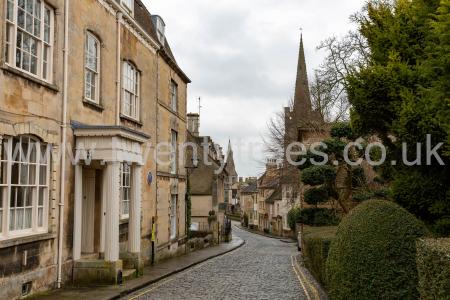
Europe, British Isles, North-Central England, Lincolnshire, Stamford, Blackfriars Friary [Map]![]()
Blackfriars Friary, Stamford [Map] was established prior to 1230 because on 13 January 1229-30, Henry III made a grant of fuel to the religious community.
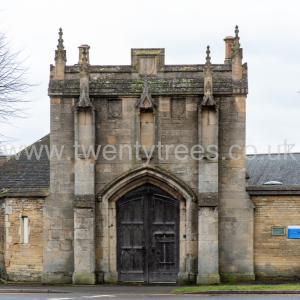
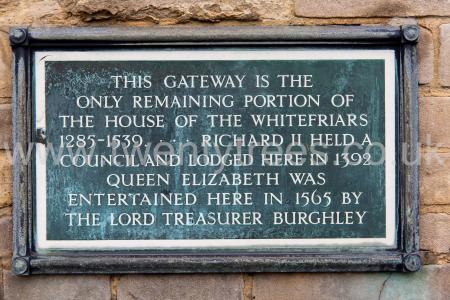
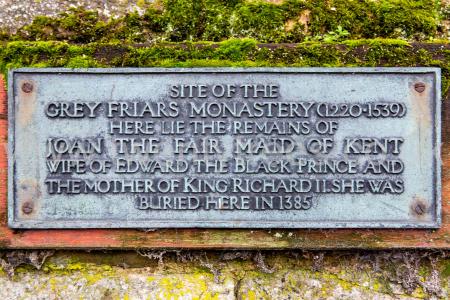 MGJKl1aDIn 1392 King Richard II of England (age 24) lodged at Blackfriars Friary, Stamford [Map] and held a Council.
MGJKl1aDIn 1392 King Richard II of England (age 24) lodged at Blackfriars Friary, Stamford [Map] and held a Council.
On 26 Dec 1360 Thomas Holland 1st Earl Kent (age 46) died. He was buried at Blackfriars Friary, Stamford [Map]. His son Thomas Holland 2nd Earl Kent (age 10) succeeded 2nd Earl Kent.
Around 12 Jul 1380 Blanche Plantagenet Baroness Wake Liddell (age 75) died. She was buried at Blackfriars Friary, Stamford [Map].
On 07 Aug 1385 Joan "Fair Maid of Kent" Princess Wales (age 56) died at Wallingford Castle [Map]. She was buried at Blackfriars Friary, Stamford [Map] beside her first husband Thomas Holland 1st Earl Kent. Her son Thomas Holland 2nd Earl Kent (age 35) succeeded 6th Baron Wake of Liddell.

Before 29 Jul 1476 the remains of Richard Plantagenet 3rd Duke York and his son Edmund were removed from Pontefract Castle [Map] to be reburied at St Mary and All Saints Church, Fotheringhay [Map]. On their journey south they spent two nights at Blackfriars Friary, Stamford [Map].
In 1534 Blackfriars Friary, Stamford [Map] was suppressed. It surrendered in 1538..
In 1565 Queen Elizabeth I of England and Ireland (age 31) was entertained at Blackfriars Friary, Stamford [Map] by William Cecil 1st Baron Burghley (age 44).

In 1828 the Stamford and Rutland Infirmary was built on the site of Blackfriars Friary, Stamford [Map]. It is now Stamford and Rutland Hospital.
Europe, British Isles, North-Central England, Lincolnshire, Stamford, Browne’s Hospital [Map]![]()
In 1475 Browne’s Hospital, Stamford [Map] was founded by William Browne, a rich wool merchant of Stamford. He was also largely responsible for enlarging and embellishing the Church of All Saints [Map] nearby. He and his wife are believed to have lived in a house adjacent the western side of the Hospital, and so would have been parishioners of All Saints', where brasses to three generations of their family may be seen.
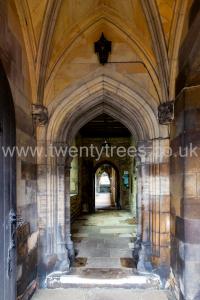
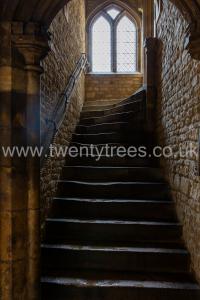
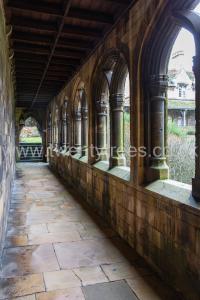
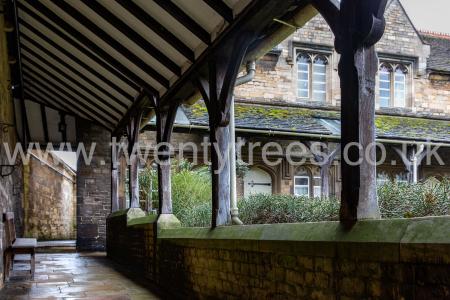
In 1485 William was authorised by letters patent of Richard Ill to found and endow the almshouse [of Browne’s Hospital, Stamford [Map]], but after his death and that of his wife Margaret, in 1489, the management of the Hospital passed to her brother, Thomas Stokke, Canon of York and Rector of Easton-on-the-Hill, just outside Stamford. Stokke obtained new letters patent from Henry VII in 1493 and the chapel was consecrated by the Bishop of Lincoln on 22nd December, 1494 [who died eight days later!].
Europe, British Isles, North-Central England, Lincolnshire, Stamford, House of the Friars Preachers [Map]![]()
Before 1241. The House of the Friars Preachers, Stamford [Map] occupied around ten acres is bounded by Wharf Road, St. Leonard's Street, Cherryholt Road, the R. Welland, and partly by Gas Street. It occupies the site of the house of Black Friars which was founded in Stamford before 1241
Calendars. On 16 Jan 1310 King Edward II of England (age 25). Stamford [Map]. To the Sheriff of York. Order to proclaim that the king does not intend to change the money current in the Kingdom in the late King's time, as had been rumoured, and to forbid anyone from thinking little of it, whereby victuals and other necessaries may be sold more dearly.
The like to all the Sheriffs of England [Ibid].
Enrolment of deed of Peter de Gavaston (age 26), knight, surrendering to the king the castle, manor, and honour of Knaresborough [Map], with the free chase of Knaresborough, and the manors of Routheclyve and Auldburgh, lately granted to him by the King for his lifetime. Witnesses: Gilbert de Clare 8th Earl Gloucester 7th Earl Hertford, Henry Lacy 4th Earl Lincoln, Earl Salisbury (age 59), John Warenne 7th Earl Surrey (age 23), John de Brittania, Earl of Richmond, Hugh "Elder" Despencer 1st Earl Winchester (age 48), Henry Percy 9th and 1st Baron Percy (age 36), Robert son of Walter, Robert son of Payn, William de Burford, William Inge. Dated at Stamford [Map] July 26, 3 Edward II.



Enrolment of like surrender by the said Peter (age 26) of the county of Gaure and the castles of Talanon, Tantalon, and Mauleon, the provostships (preposituras) and Camparian(um) called 'la Cointal' and of the city of Bayonne, the manor of Erebafaveyra, Born, Comtad, Salmun, Dagenes, and the island of Oleron, and the lands of Marempne and of Lancras in Saintogne, and all rights, appurtenances, etc., etc., thereto pertaining to the king, which the king lately granted him for life. Witnesses as above. Dated August 4, 3 Edward II.
Memorandum, that this deed was delivered to the king in his chamber in the House of the Friars Preachers, Stamford [Map] at Stamford, by the hands of the said Peter (age 26) and the king delivered the said deed to J his chancellor, to be enrolled in the chancery, and it was afterwards delivered to Ingelard de Warle, keeper of the King's Wardrobe to be kept in the king's wardrobe, but the king's charters that the said Peter hereof were not then restored.[CONTINUES].
Around Apr 1324 King Edward II of England (age 39) spent Easter at the House of the Friars Preachers, Stamford [Map], and gave a pittance to thirty-eight friars preachers, who presented him with sixty pears.
On 14 May 1332 King Edward III of England (age 19) spent Easter at the House of the Friars Preachers, Stamford [Map], and paid fifty marks to the friars for damages done by the royal household.s
In 1335 King Edward III of England (age 22) was at House of the Friars Preachers, Stamford [Map] and on several occasions gave the friars pittances.
Europe, British Isles, North-Central England, Lincolnshire, Stamford, Queen's Cross
On 05 Dec 1290 Eleanor of Castile Queen Consort England (deceased) body rested at Queen's Cross, Stamford.
On 12 Mar 1470 Richard Welles 7th Baron Welles, Baron Willoughby (age 42) and Thomas Dymoke (age 42) were beheaded at Queen's Cross, Stamford. Note. Some sources say on battlefield immediately prior to the battle.

Europe, British Isles, North-Central England, Lincolnshire, Stamford, Ryhall Hall
Henry Chaplin A Memoir: Youth II. Henry Chaplin (age 1) was born on December 22, 18411, at Ryhall Hall near Stamford, being the third son of the Rev. Henry Chaplin (age 52), the Lord of the Manor and Rector of the Parish, and of Caroline Horatia (age 26), a daughter of William Ellice of Invergarry, M.P. for Great Grimsby, and niece of Horatio Ross.
Note 1. There was some doubt as to the year of his birth. See p. 146.
Europe, British Isles, North-Central England, Lincolnshire, Stamford, St George's Church
In Sep 1540 David Cecil (age 80) died. He was buried at St George's Church, Stamford.
On 30 Oct 1680 Richard Cust 2nd Baronet was baptised at St George's Church, Stamford.
On 25 Jul 1734 Richard Cust 2nd Baronet (age 53) died. He was buried at St George's Church, Stamford. His son John Cust 3rd Baronet (age 15) succeeded 3rd Baronet Cust of Stamford in Lincolnshire.
Europe, British Isles, North-Central England, Lincolnshire, Stamford, St Leonards Priory [Map]![]()
St Leonards Priory, Stamford [Map] was a priory in Lincolnshire, England. It was built in Stamford, supposedly on the site of a monastery which was founded by St Wilfrid in 658 and destroyed in the Danish invasion.
It was jointly refounded by William the Conqueror and William de St-Calais, the Bishop of Durham, around 1082 and remained a cell of Durham until its dissolution in 1538.
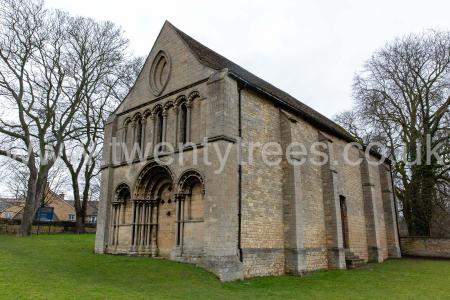
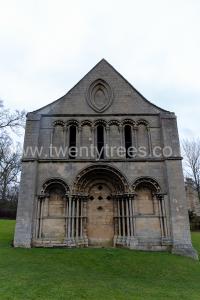
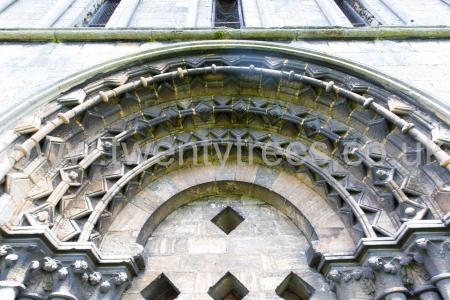
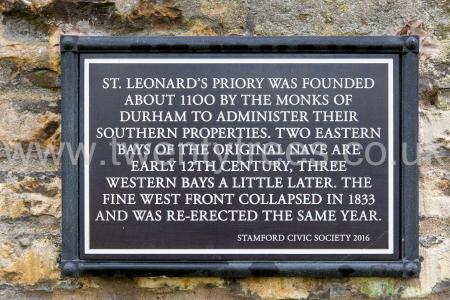
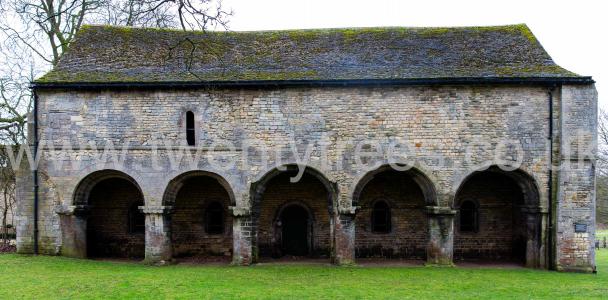
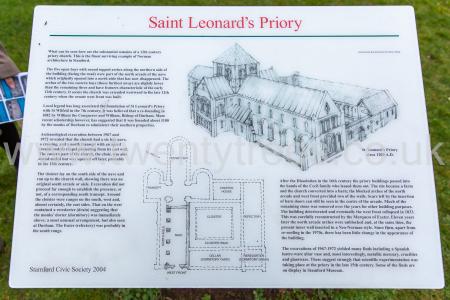
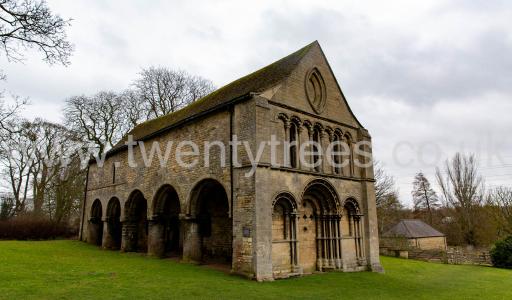
Europe, British Isles, North-Central England, Lincolnshire, Stamford, St Paul's Church [Map]![]()
St Paul's Church, Stamford [Map] was first constructed around 1152. It was in the patronage of the Priory of Saint-Fromond in Normandy in the mid eleventh century but had come into the hands of lay patrons by 1413. Amid the upheavals of the Reformation, Stamford School, founded in 1532, left its original home in the Corpus Christi chapel of Stamford's St Mary's church and moved into the remaining section of St Paul's church on the north side of St Paul's Street.
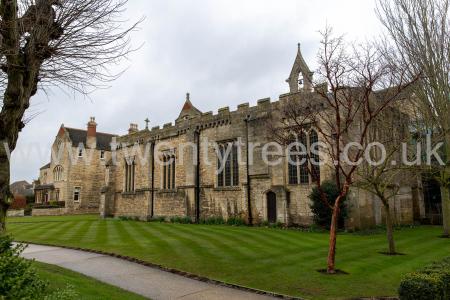
Europe, British Isles, North-Central England, Lincolnshire, Stamford School
Around 1532 William Cecil 1st Baron Burghley (age 11) educated at Stamford School, Lincolnshire.
Europe, British Isles, North-Central England, Lincolnshire, Stamford, Uffington Church
In Jun 1591 Thomas Manners (age 54) died. He was buried at Uffington Church, Stamford.
On 12 Dec 1607 Roger Manners (age 72) died at Enfield [Map]. He was buried at Uffington Church, Stamford.
In 1670 Bishop Thomas Sprat (age 35) was appointed Rector of Uffington Church, Stamford.